The Patriot Hellfire M.2 480GB Review: Phison NVMe Tested
by Billy Tallis on February 10, 2017 8:30 AM ESTMixed Random Read/Write Performance
The mixed random I/O benchmark starts with a pure read test and gradually increases the proportion of writes, finishing with pure writes. The queue depth is 3 for the entire test and each subtest lasts for 3 minutes, for a total test duration of 18 minutes. As with the pure random write test, this test is restricted to a 16GB span of the drive, which is empty save for the 16GB test file.
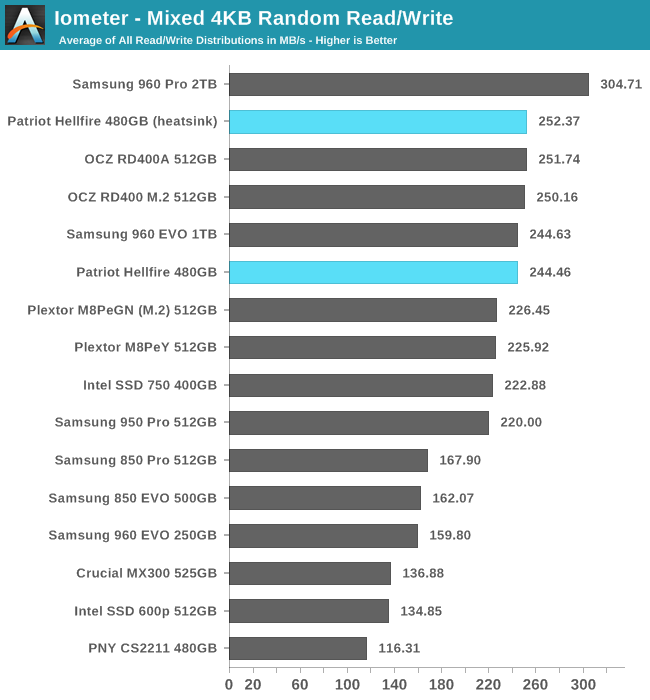
The Patriot Hellfire has great performance on the mixed random I/O test, tying the OCZ RD400 and falling behind only the much larger 2TB Samsung 960 PRO.
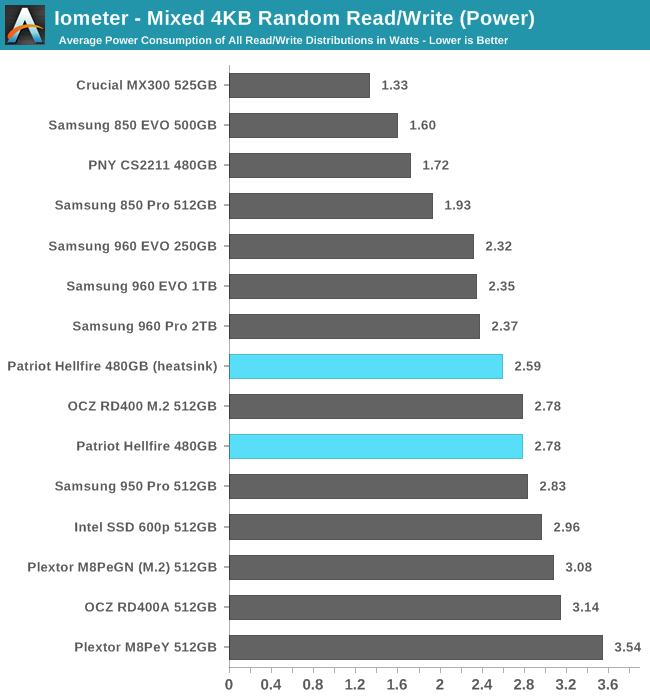
The Patriot Hellfire draws more power than the Samsung drives, but otherwise is one of the most efficient drives on the mixed random I/O test.
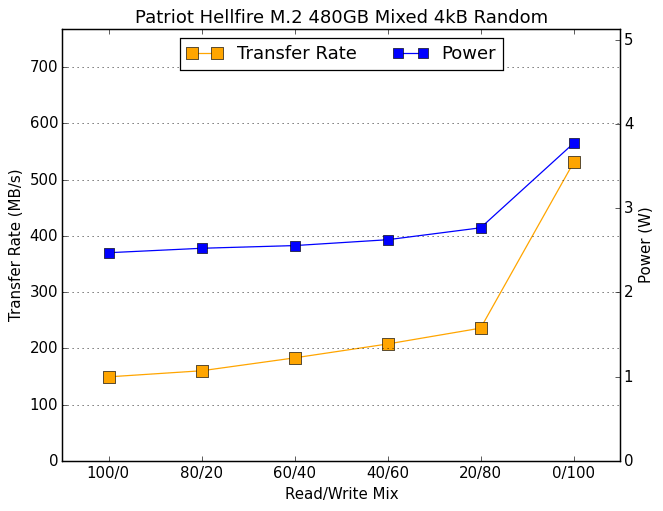 |
|||||||||
Performance increases slowly but steadily as the portion of cacheable writes increases, but the spike in performance when the workload shifts to pure writes is not as big as exhibited by some of the Patriot Hellfire's competitors.
Mixed Sequential Read/Write Performance
The mixed sequential access test covers the entire span of the drive and uses a queue depth of one. It starts with a pure read test and gradually increases the proportion of writes, finishing with pure writes. Each subtest lasts for 3 minutes, for a total test duration of 18 minutes. The drive is filled before the test starts.
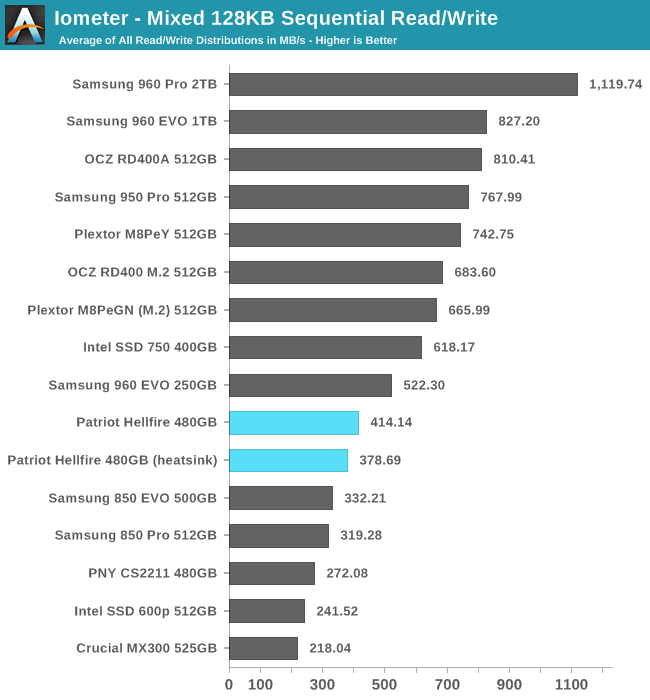
The Patriot Hellfire turns in the second-worst performance from a PCIe SSD, but at least it is still clearly faster than any SATA SSD. Even the 250GB Samsung 960 EVO fares better. This test is another sign that the Patriot Hellfire does poorly when full.
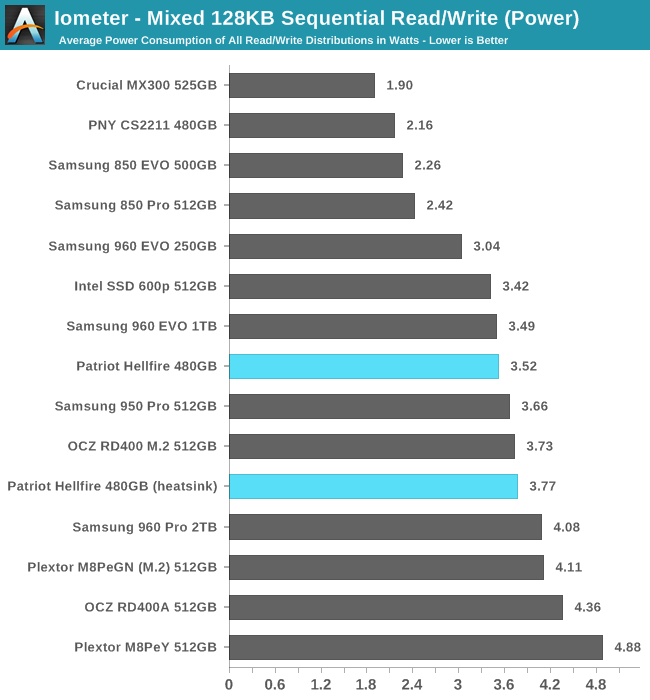
The Hellfire's power consumption across the mixed sequential I/O test is about average for an NVMe SSD, so its overall efficiency is fairly poor.
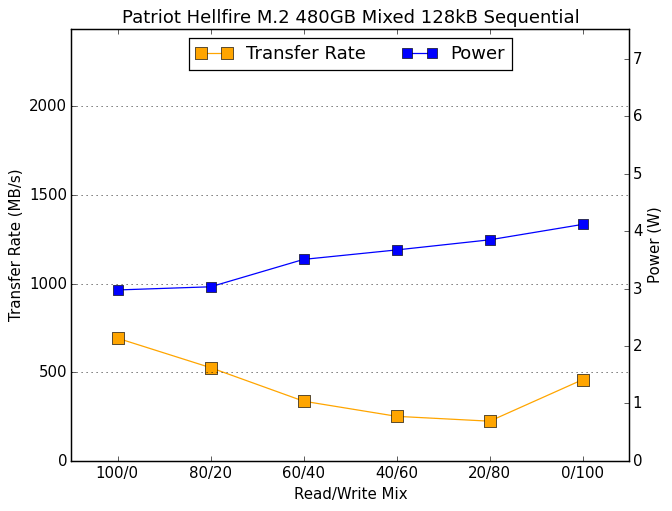 |
|||||||||
The addition of a heatsink only slightly improves the minimum performance of the Patriot Hellfire across the mixed sequential I/O test, and actually led to slightly reduced performance overall.










43 Comments
View All Comments
Magichands8 - Friday, February 10, 2017 - link
The problem is that there's nothing cheap about these. In fact, price per GB for SSDs seems to be going up even for the 'just good enough' crowd! And after all these years capacities are still a joke. To me, those are much bigger concerns than the name given to the drive. But we're going to have to put up with it for quite a while by simply not buying anything. Companies are going to keep doing this as there's apparently a large part of the buying public who are determined to throw pearls before swine on overpriced and low capacity SSDs. At least Patriot has done SOMETHING about the performance aspect.Murloc - Friday, February 10, 2017 - link
you're wrong, I can now buy something double the size and with better performance at the same price I bought my 840 evo.MR_Roberto - Monday, February 27, 2017 - link
ehh? tell me what product that is.. i want to buy it xDphexac - Friday, February 10, 2017 - link
Now, that is one crappy SSD.jjj - Friday, February 10, 2017 - link
You guys should use these traces to measure power consumption in CPU reviews.There is way too much focus on "max load". Guess AT does have some more relevant tests for laptop reviews but in CPU reviews, the power section is tragic.
Billy Tallis - Friday, February 10, 2017 - link
Unfortunately, these traces are just playing back the I/O, not actually re-running the whole application. The CPU load they present is trivial.jjj - Sunday, February 12, 2017 - link
Hmm so that can distort the SSD perf tests a bit for workloads that are CPU heavy.Maybe a dedicated article would be interesting. Even more so when you get Xpoint drives, next year i guess for proper capacities.
Guess the SSD power tests could factor in perf and CPU utilization for extra accuracy.
Billy Tallis - Monday, February 13, 2017 - link
The distortion should be minimal. Recording the traces in the first place incurred very little overhead. The trace doesn't perfectly capture the dependencies between operations, but the playback does preserve the ordering and queue depths and relative timing, except that long disk idle periods are cut short. I'll cover this in detail in when I launch the 2017 test suite.BurntMyBacon - Monday, February 13, 2017 - link
Your efforts are appreciated.jjj - Monday, February 13, 2017 - link
Just to be clear, i was thinking the CPU becoming a bottleneck in some situations and that there might be significant differences in CPU load per unit of perf between SSDs that could lead to significant differences in real usage.